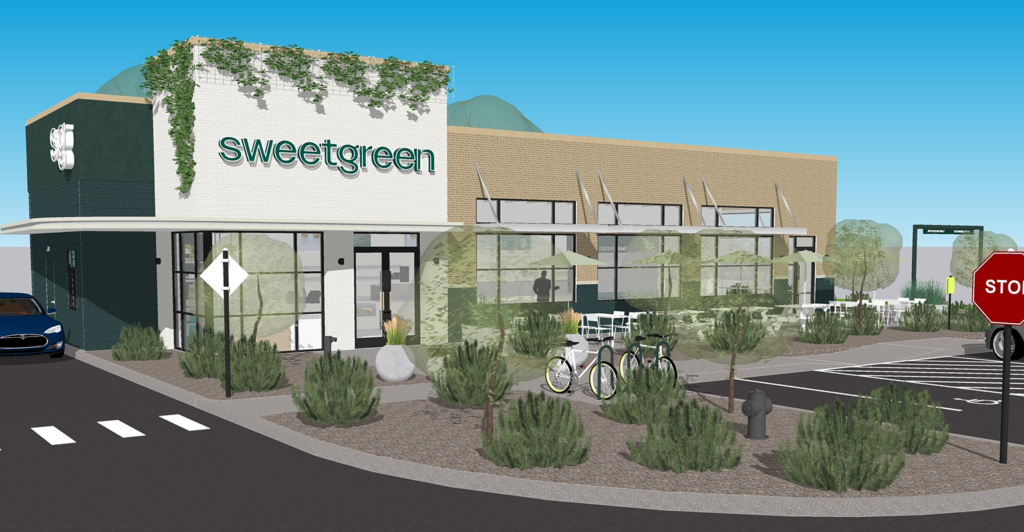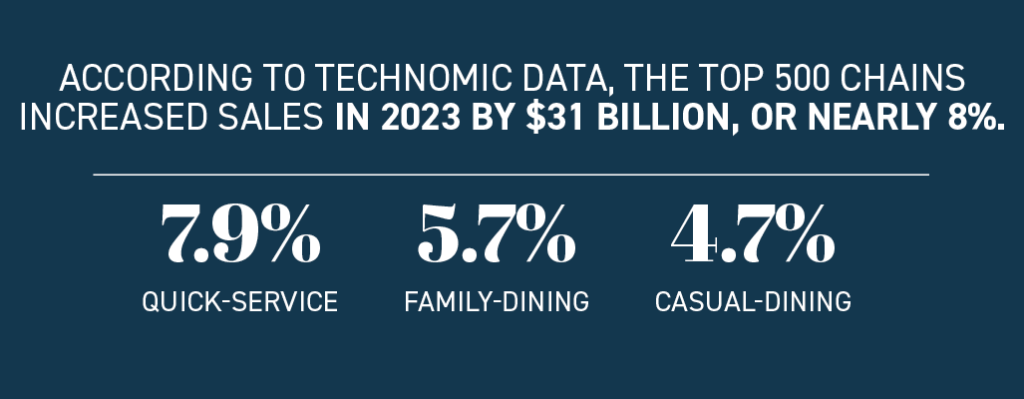Today’s restaurant growth pinch points: financing, labor, real estate
With lingering inflationary pressures, the industry has started to accelerate toward bifurcation.
22 May 2024
Share this exclusive content from Saladplate

Photo Credit: Sweetgreen
What does “growth” mean for restaurant businesses in this “new normal”? Find out below and throughout the Growth Report:
• More than ever, growth is impacted by geographic variations
• This segment has emerged as the sweet spot for industry growth
No matter how it’s defined, growth in any capacity requires capital and capital remains expensive; the Fed raised interest rates 11 times between March 2022 and July 2023 to combat relentlessly high inflation. A cooldown has yet to happen, which has kept a lot of investors on the sidelines.
Of course, there’s an ironic twist at play here. Those rates remain high because demand remains high. Driving much of this environment is a sturdy set of consumers with more wages in their pockets and a continued pent-up demand from the pandemic. Those consumers, especially younger ones, have also proven that they really, really like to frequent restaurants. And so here we are, with a murky understanding of what exactly growth means at this post-pandemic juncture.
The consensus is that most of the industry’s growth from this point will come from higher demand concepts focused on convenience. High rates haven’t derailed the quick-service or fast-casual segments, for instance, or many bigger players in general. According to Technomic data, the top 500 chains increased sales in 2023 by $31 billion, or nearly 8%. During the recent Restaurant Leadership Conference, Technomic Managing Principal Joe Pawlak called it a “very, very strong growth year” for those at the top.
Indeed, in this strange environment in which many concepts are relying on pricing to offset inflation across the board, the big have gotten bigger, with those top 500 generating about $424 billion of the industry’s roughly $1 trillion in sales.
“For smaller mom and pops and independents, this environment can be soul crushing. It has become harder for them to compete on convenience and price,” Sharon Zackfia, head of the consumer sector at equity research firm William Blair, said during a recent interview. “Scale matters when negotiating procurement, labor tools, the ability to invest in AI/robotics. Mom and pops usually can’t do that as much. We’re at a stage where the big are getting bigger, and that is accelerated by some forces.”
This momentum is expected to continue for bigger players this year, particularly among QSRs with a franchising model. The QSR segment is expected to increase its total franchised units by 2.2% to reach 199,808 compared to 195,507 in 2023, according to the International Franchise Association’s 2024 Franchising Economic Outlook. This translates to over 4,300 franchised restaurant openings.
That’s not to say things will be easy for them, however.
“Franchisees have been used to a low interest rate environment for decades. For that community, it’s been tough to digest higher rates,” Zackfia said. “Much of this community also happens to be in limited service, so the fight for boxes is now more intense.”

According to Technomic data, the Top 500 chains increased sales in 2023 by $31 billion, or nearly 8%.
The fight over real estate intensifies
The boxes, or real estate, have indeed become a more aggressive battle zone. According to JLL, real estate inventory for restaurants in many markets is at an all-time low. In Houston, for example, there is only a 4% commercial vacancy rate.
“The prevailing issue is growth is slowing down because of issues with real estate, rent, and construction,” said Fernandez of investment firm Full Course. “The pandemic caused a shortage of real estate and it’s a nationwide problem. What happens then is rent gets crazy high, so now not all restaurants can afford this space. What used to be a normal occupancy cost, around 10% or so, is now much, much higher.”
As more fast-casual concepts, like Sweetgreen and Shake Shack, start to aggressively add drive-thru models to their mix in response to consumer demand, this battle will just intensify even more, bringing costs up along the way.
“There is generally more focus on the drive-thru than there was in 2019, particularly in fast casual, which has made that a meaningful focus of development,” Zackfia said. “Fast-forward three years from now and that puts those concepts in more of a direct competition with the traditional drive-thru players.”
Still, brands want to grow, so they’re absorbing the higher occupancy costs anyway and compromising some returns along the way.
The labor genie is out of the bottle
And then there’s labor, which is also historically high. And, unlike other inflationary pressures, once labor costs reach a certain point, the genie doesn’t go back into the bottle. In California — where the minimum wage just increased to $20 an hour at QSRs, with an impact expected across segments — that means even more bifurcation between the big and not-so-big players.
The impacts are expected to trickle into other segments as the dynamic shifts over labor competition, and companies big enough to absorb additional costs will outpace those who simply cannot. Though wages just increased in the beginning of April, there have already been signs of these shifts, according to Blake Kaplan, managing director on JLL’s national restaurant team.
“The Band-Aid has been ripped off and it has transformed the food space. The reality is there have been a lot of brands wanting to engage in California for many years, and with inventory at an all-time low, and costs high, we’re starting to see a lot of stale brands move out and new brands or brands with high revenue projections starting to have more of an opportunity,” Kaplan said. “It’s become a bit of a feeding frenzy of closures making room for other brands to move in. In the next year or so, we’ll see more polished brands take over vacancies. There is still a lot of competition here despite economics.”
Still, the confluence of pressures is leading to more modest growth and, some believe, a turning point. Kaplan believes there could be more restructuring deals on current leases, for instance, or more companies moving into a franchised model to offload some of the burden. Indeed, the entire franchisor/franchisee relationship will be impacted to ease franchisees’ pressures, whether it’s through technology kickbacks, lower royalty packages, or otherwise.
“A rate-cutting environment will happen at some point and will spur more development. That part of the equation will get easier,” Zackfia said. “Labor won’t, so franchisees have to look to their franchisors to think about ways they can become more efficient.”
Winners and losers
In the meantime, pressures remain and with debt more expensive, more brands have become distressed. U.S. bankruptcies reached a 13-year peak in 2023, and those filings included major franchisees from Burger King, CKE, McDonald’s, Popeyes, and Denny’s. In this environment, plenty of operators have leveraged too much debt, fallen behind on vendor payments, violated liquidity covenants, and repeatedly kicked the ball down the road on rent.
“When debt was cheap, everyone took it out to grow, and now brands are suffering. Typically, when brands do their deals, they build in elaborate return models, but no one modeled for (these interest rates). We knew some kind of rate was going to happen, but not this much,” Fernandez said. “Now, a lot of brands are in trouble and a lot of investors are looking at severely reduced returns.”
This would be less of a problem if sales were high, but they’ve also slipped since the post-pandemic boom of 2022 and early 2023. The result, according to Fernandez, is that “not a lot of people are doing deals right now.” That said, Fernandez doesn’t lack optimism.
“Investors who have been doing this a long time know this is a drop in the bucket. If you’re a fair-weather investor in this space and you’re just here because you’ve seen dollar signs for years, you’re going to run for the hills,” she said. “If you’ve been investing in this space for a long time, you know there is a lot of consumer demand and that we’ll adjust and adopt new tech and in the long run, it’ll be fine.”
As for the operator side of things, Zackfia reiterates that there will be an accelerated bifurcation, but that split won’t just be measured by scale.
“There are winners and losers right now. The winners are those with quality and experiences. The commodity restaurants in the middle, where it’s difficult to differentiate, that’s where it’s challenged,” Zackfia said. “If you can be experiential and aren’t thrown into the commoditization bucket, or you have convenience with quality, you should be in a better position. Restaurants that haven’t figured out how to evolve with the consumer are stuck in the middle and they’re not growing as quickly — or at all.
“This is not an easy environment. But it’s not impossible. You can navigate it, but you need a steering wheel.”

Source: Nation’s Restaurant News



